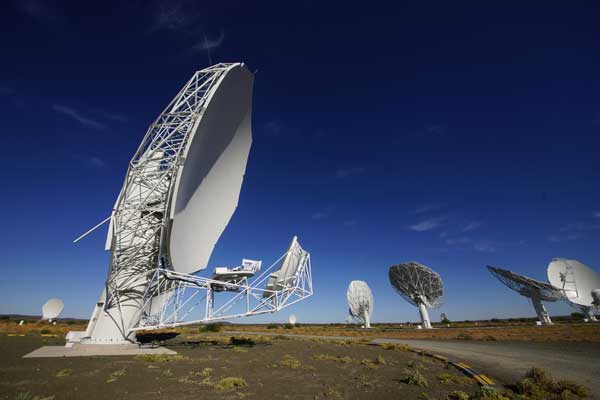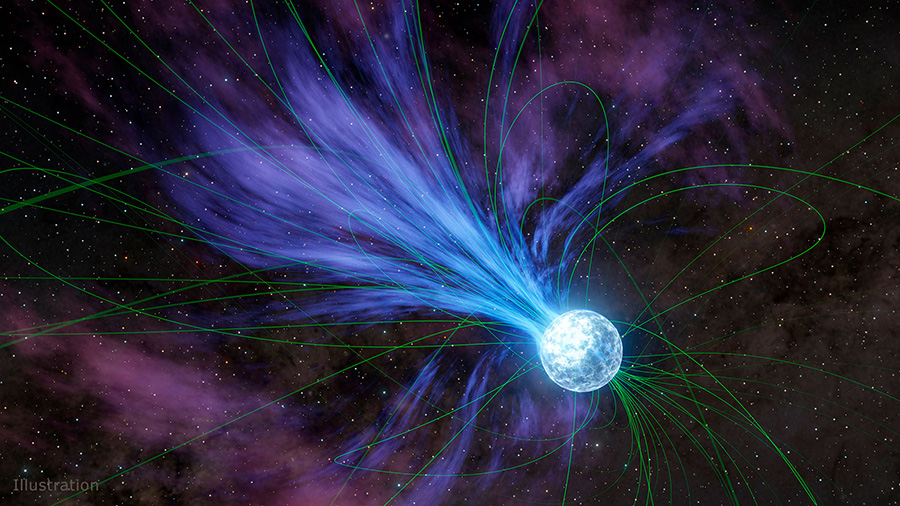NASA / JPL-Caltech
Astronomers have detected the farthest fast radio burst (FRB) yet. The ultra-brief burst of radio waves registered by the South African MeerKAT observatory on March 4, 2024, was produced more than 10 billion years ago, long before the formation of the Sun and Earth. The find, first announced at the FRB2025 conference in Montreal, Canada, in July, “marks a critical milestone in FRB astronomy,” according to the discovery team in a paper published on the arXiv preprint server earlier this month.
Radio waves slow down slightly as they travel through tenuous interstellar or intergalactic matter, with the effect being stronger for longer wavelengths. For the new burst, this dispersion measure was unusually large, suggesting a correspondingly large distance.
Follow-up observations with the Keck telescope on Mauna Kea, Hawai’i, and with the MMT Observatory in Arizona, didn’t show a host galaxy candidate at the location of the burst, in the northwestern part of the constellation Virgo. But subsequent observations with the James Webb Space Telescope were more successful. JWST’s Near-infrared Camera found a 28th-magnitude smudge of light at the burst’s location — a dwarf galaxy undergoing a strong burst of star formation.
“The host galaxy is unexpectedly small and has a very low luminosity,” says radio astronomer Joeri van Leeuwen (ASTRON, the Netherlands), who was not involved in the study. “It’s impressive that they’ve been able to observe it anyway.”
Using Webb’s NIRSpec spectrograph, the team, led by Manisha Caleb (University of Sydney), measured how much the galaxy’s light waves are stretched by cosmic expansion during their long trip to Earth. From this redshift (2.148, about twice the previous record for a fast radio burst), it followed that the burst occurred when the universe was just some 3 billion years old.
Since the discovery of the first fast radio burst in 2007, a few thousand have been detected to date, most of them by the Canadian Hydrogen Intensity Mapping Experiment (CHIME). But astronomers still don’t know exactly what produces the energetic explosions, which unleash about as much energy in a few milliseconds as the Sun does in a week.

Govert Schilling
Most theorists think that magnetars are the culprit: incredibly strongly magnetized neutron stars. But while neutron stars are the small, dense remnants of exploded giant stars, the origin of magnetars is less clear. They could form right after the stellar explosion, or much later, when two neutron stars merge.
In their paper, Caleb and her colleagues argue that the distant burst may help solve the riddle. Neutron star mergers ought to be more common in older stellar populations, where these compact supernova remnants abound. In such older galaxies, the massive, short-lived stars that made the neutron stars in the first place are long gone. But the host galaxy of FRB20240304B, as the burst is known, is young and churning out stars (and stellar remnants) at a high rate. That suggests that – at least in this case – the magnetar formed shortly after a supernova explosion, and didn’t require a much later merger.
According to Ziggy Pleunis (University of Amsterdam), who wasn’t part of the team, detections of more high-redshift bursts will also shed light on the evolution of the universe — in particular on the way cold intergalactic gas accumulated into galaxies.
Because of the effect on their dispersion measure, “FRBs are a unique tool to measure the distribution of this otherwise invisible gas in intergalactic space,” he says. “The new find opens up the possibility to do this back until about 3 billion years after the Big Bang.”
Thanks to its high sensitivity and angular resolution, the 64-dish MeerKAT observatory is expected to find and localize more such distant fast radio bursts in the future. According to Pleunis, “it’s no surprise that other radio telescopes haven’t yet succeeded in detecting FRBs from so long ago.”

